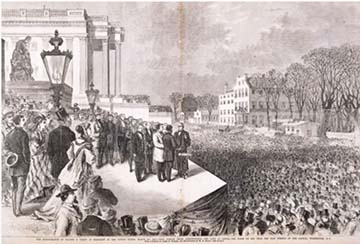Echoes of Reconstruction: President Grant Reorganized the White House As Soon As He Took Office

ECW is pleased to welcome back Patrick Young, author of The Reconstruction Era blog
Ulysses S. Grant was sworn in as president on March 4, 1869. The immensely unpopular incumbent Andrew Johnson was finally deposed. The new President’s wife Julia Dent Grant described that day:
General Grant left his residence…in his own carriage accompanied by some friends. I know he did not ride up to the Capitol with the ex-President. He absolutely refused to do so. I went with a large party to the Capitol, where I heard the oath of office and listened with pride and emotion to the first inaugural address of my husband, the President.
Nine days later, on March 13, the Charleston Daily News reprinted a denunciation of the new president published by the Baltimore Gazette that warned that the new president would be ruled by his own “intense Negroism.” This prejudice in favor of Blacks would, the newspaper claimed, lead to “the torture of the South.” The evidence of Grant’s intentions was contained in his first presidential document, which called for the ratification of the 15th Amendment giving African Americans the right to vote.
Grant did champion the rights of Africans right from the start of his presidency, he advocated ratification of the 15th Amendment in his inaugural address, but he also tried to reorganize a White House that had expanded enormously under Abraham Lincoln and the necessities of the Civil War, and had suffered through the chaotic years of Andrew Johnson’s presidency. The last year of the Johnson Administration had been dominated by the months-long effort to impeach the president and repeated rumors that Johnson and his opponents were plotting to use force to secure control of the presidency.
One innovation of Grant’s first weeks in office was the creation of a sophisticated White House Staff system outside the need for approval by the Senate. Congress had only begun funding a White House staff in 1857, but the funding had allowed Abraham Lincoln to hire private secretaries to assist him during the war. Many of Grant’s new staff would be paid by the Army because they were officers with whom he had worked with before who were now detailed to the White House. Rather than serve as general-purpose presidential functionaries, the staff members were assigned specific roles.
Horace Porter and Orville Babcock responded to correspondence. Porter, in his early 30s, had served as private secretary to Grant in the army. Babcock, also in his 30s, had been aide-de-camp to Grant beginning with the Overland Campaign. During Reconstruction he continued to serve Grant as an aide and he was given the mission of investigating Reconstruction in the South. He reported to Grant in 1867 that former Confederates were organizing to restore all-white control over Southern state and local governments.
Grant’s brother-in-law Frederick Dent was a West Point graduate who had served for a decade and a half in the regular army. During the Civil War he was also an aide to Grant. When Grant took office, Dent was assigned to run the receiving room at the White House, an innovation. Since the linking of Washington to the rest of the country by rail in the 1840s, the president’s home had become one of the most visited places in the country. Under Dent, visitors would be screened before being given access to Grant.
The use of active duty military men to staff the White House led to fears of encroaching military control over the civilian government among Democrats. Orville Babcock emerged as Grant’s “major domo,” according to historian Charles W. Calhoun. Babcock managed patronage within the administration and fed information to friendly newspapers on Grant’s opponents, feeding into the increasingly paranoid idea of a drift towards dictatorship. The feared military dictatorship was, of course, never installed, but future presidents followed Grant’s model of staffing.
This month is the 200th Anniversary of Grant’s Birth. While Ulysses S. Grant is ancient enough to have his Bicentennial celebrated, he was a central figure in creating the modern United States.
I have compiled a list of events around the United States commemorating the Grant Centennial:
https://thereconstructionera.com/list-of-u-s-grant-bicentennial-events-in-april-may-and-june/
Thanks!
If really want to know this great President and General read his memoirs written in two volumes. Many of the things that was published about him are not true. He had great men around him to assist him during the war and as president.